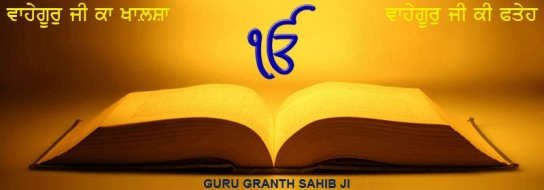
Approaches to the Exegesis of Sri Guru Granth Sahib
Introduction
The Guru Granth Sahib is a sacred scripture of the world and is the Eternal Guru of the Sikhs. Because it is a scripture suitable of a universal religion, many world class philosophers and holy men consider it a unique treasure and a noble heritage for all humankind. Because, it is the Guru of the Sikhs, its adoration or veneration is an article of faith with the Sikhs. In 2008, the Sikhs celebrated the Tercentennial of the Canonization of the Granth as the Sri Guru Granth Sahib.
In mystic literature of Guru Granth the appeal of the numinous becomes ineffable, if not inexplicable. And yet the great Sikh scripture is not a knot of metaphysical riddles and abstract theorizing. For the most part it employs the idiom of the common people, and draws its imagery and metaphors from the home, the street and the work place. The hymns of the Guru Granth show an admirable use of the current figures of speech apart from their metrical richness and sweetness. Imagery was taken from everyday life and common occurrence to simplify subtle thoughts and profound concepts. The Gurus were keen lovers of nature and as such, have written glowing descriptions of panoramic environmental beauty, changes in the times of day, and the changes of seasons to inculcate love for the One Creator. Thus they made Guru Granth poetry an extraordinary breed of divinity, mysticism, immediacy, concreteness and urgency with which it touches the human heart.1
One of the greatest glories of the Guru Granth is its all-embracing character. It is a scripture completely free from bias, animus and controversy. Indeed, the uniqueness of the Guru Granth in this respect is all the more astonishing when we think of the obscurantism, factionalism and religious fanaticism of the periods in which it was composed. They were all counterbalanced by inclusion of the songs and verses of a wide diversity of holy men, saints, savants and bards. Of course, their hymns and couplets rendered in their own language and idiom were so dovetailed as to find a complete correspondence with themes or motifs in the compositions of the Sikh Gurus.
The Exegesis of Sri Guru Granth Sahib and its Importance
According to Gurnek Singh2: The religion is based on the experience of the metaphysical reality, i.e. God or Numinous. This experience is the result of the direct encounter or the communication with this reality. As a consequential effect it comes down to us through non-rational media, i.e. the intuition which is beyond intellectual understanding and comprehension. So being the product of direct vision of the ultimate reality, i.e. God, it is intellectually both unapproachable and intelligible because the language through which the Bani or revelation is coming down to humanity is most of the time symbolic, metaphorical and allegorical. Man's mental encounter with his surroundings result in expression of his feelings. It was and is always in local language such as English, Sanskrit, Pali, Punjabi and Arabic etc. For man deals with this phenomenal existence and that is why the expression of man is easily comprehensible. But the category which is non-mundane, which is non-rational, i.e. divine or intuitional is beyond proper intellectual comprehension.
So viewed thus the term exegesis or interpretation or exposition is of great eminence, for it unfolds the hidden, i.e. esoteric meanings or message of scripture. Otherwise the scriptural message would be beyond the comprehension of layman as well as scholar. So to impart the message to the people in general, and the scholars in particular, the endeavours have been made to decode both literal as well as esoteric message enshrined in the scripture to the people at large.
Viewed thus the exegesis of Sri Guru Granth Sahib is of great import. Because its message from the philosophical, theological and sociological points of view will enhance the comprehension and understanding of men. For the philosophical, theological and sociological comprehension and its implications and concepts shall certainly lead man to imply the Sikh thought on mundane level consequently building and establishing the better world wherein peace, happiness and prosperity shall reign supreme and in this way in the words of Bhagat Ravidas, the Halemi Raj shall be established, wherein peace shall prevail and trials and tribulations shall cease to be operative. In this way pragmatic aspect will benefit more. The better social order shall come into existence which shall provide the chance to men to live peacefully and happily. In this way scriptural message shall help to decrease the sufferings of man and will lead man to establish a beautiful world worth living. That is why the above mentioned tool exegesis has been used and implied to decode the message of the scripture. It has been used in various religious traditions such as Tafsir in Islamic tradition, Exegesis in Christianity and Tika or Pramarth in Sikh Tradition has been employed for this purpose. Thus from the preceding discussion we have established a point that the exegesis carries weight and is of great eminence in decoding the divine message enshrined in the scripture."
Origin and Approaches to Exegesis of Sri Guru Granth Sahib (SGGS)
It is often said that the interpretation of a scripture begins soon after its compilation. The same is true in the context of Guru Granth Sahib also. For the true interpretation of Guru Granth Sahib and Sikhism, the Sikh Gurus themselves have explained how to understand and interpret the bani or its belief system. As it is evident from the Sikh history that the most important school of interpretation originated in the lifetime of the Gurus themselves. The first effort to interpret the Gurbani besides the Gurus was made by Bhai Gurdas. It is said that when Guru Granth Sahib was installed in the Harimander Sahib, the practice of exposition of Gurbani was started. Since then, the tradition of interpretation continued in one form or the other.3
There is no historical evidence that SGGS was interpreted in the common language of the masses during the Guru period. However, there is a strong oral tradition that SGGS katha was held regularly in major Gurdwaras/Dharamsalas during and after the Guru period. It is part of recorded history that Guru Gobind Singh anointed Pothi Sahib as Sabad Guru of the Sikhs, a day before his demise at Nander. This recension of Guru Granth Sahib was prepared at Talwandi Sabo (Damdama Sahib), popularly known as the Damdami Bir, by Guru Gobind Singh after dictating the holy text to Bhai Mani Singh, verbatim. SGGS was interpreted to Sikh Sangat at Damdama Sahib by Tenth Master himself. Baba Deep Singh was working as a scribe at Damdama Sahib under the tutelage of Guru Gobind Singh and the origin of Damdami Taksal is ascribed to him. Thus the historical roots of Sikh exegesis are traced back to Damdama Sahib in Sikh parlance.
During the eighteenth century and up into the early part of the nineteenth, the task of interpreting and preaching the Holy Guru Granth Sahib primarily rested with the Udasi and Nirmala teachers.4 Even in the worst days of Islamist persecution they were left unmolested and in control of Sikh shrines and institutions; this continued during the time when Sikhs had established authority in the Punjab. All instruction was carried out orally. The only writings of this period were the Rahitnamas which were, strictly speaking, rules of conduct rather than works of exegesis. The first Udasi exegete of this period who left a written record of his scriptural studies was Anandghana, who completed his tika of Japu in 1795, followed by exegeses of several other banis. Anandghana was the first to separate historical account from interpretative comment. His interpretations are saturated with Upanisadic lore and are densely Vedantic rather than Sikh, and are apparently a conscious reincubation of Hindu ideology in Sikh thinking.
Nirmala scholars generally echoed the Udasi trend of interpreting Sikh scriptural texts in the inflated style prescribed by Hindu commentators on Upanisadic and Vedic texts. Bhai Santokh Singh (1788-1843), the most prominent among the Nirmalas, did write his Garabganjani Tika (Tika to humble the garab, i.e. pride of Anandghana) in criticism of Anandghana's interpretations in his Japu Tika, but he too was writing from within the Hindu framework and represented a deep Brahmanical influence. Besides tikas, annotation of scriptural writings continued to flourish throughout the nineteenth century in the form of Praydi (glossaries) and Kosh (dictionaries), two prominent examples being Granth Guru Girdrath Kosh (1895) and Praydi Adi Sri Guru Granth Sahib Ji De (1898) by Pandit Tara Singh Narotam.
A new phase of exegetical writing began when the western scholar, Ernest Trumpp began his, end to end, English translation of the entire Guru Granth Sahib. But Trumpp's scorn for traditional interpretations of the faith, and his overt antipathy towards it, earned him the reproach of the entire Sikh people. Following the publication of Trumpp's work in 1877, unfinished though it remained. Raja Bikram Singh, ruler of Faridkot (1842-98) and patron of the Amritsar Khalsa Diwan, commissioned a full scale commentary in Punjabi on the Guru Granth Sahib. The first draft prepared by Giani Badan Singh of Sekhvari was ready by 1883. It was then revised by a synod of Sikh scholars representing a wide variety of schools of thought then current among the Sikhs, with Mahant Sumer Singh of Patna Sahib as chairman.
The revision was completed during the time of Raja Bikram Singh, but he did not live long enough to see publication of the work he had sponsored. The printing started during the reign of his successor, Raja Balbir Singh (1869-1906). Three volumes came out during his time and the fourth and final one during the reign of his successor, Maharaja Brijindar Singh (1896-1918). By this time the first edition had already run out. A large number of the sets had been presented free of cost to Gurdwaras and to scholars. The rest were sold at a nominal price.
Meanwhile, suggestions for further revisions and for the use of standard Punjabi instead of Braj in the exegesis had been pouring in from various Singh Sabhas and Khalsa Diwans. The Maharaja ordered, in August 1918, the formation of a revision committee and, pending the revision, ordered the publication of a second edition to meet the immediate demand. However, his untimely death a few months later (22 December 1918) upset the entire plan. The proposed revision never took place, though a second edition did appear in 1924. Maharaja Brijindar Singh's successor Raja Harindar Singh was averse to the idea of a revision. He used to say that the tika had been commissioned by his ancestors and it must remain in the same form and style in which they had left it. The original copy of the tika is still preserved in the toshakhana of the late Raja. There have, however, been reprints of the original published by the Languages Department (Bhasha Vibhag) Punjab, the first one in the series appearing in 1970.
Gurnek Singh has discussed the various approaches to Sikh exegesis in his wonderful paper.2 He has covered all works of Western Scholars starting from Colonel A.L.H. Polier right up to W.H. Mcleod and his Sikh Scholars. He made an elaborate study of their writings about Sikh faith. He has praised Macauliffe for his interpretation of message of Sikh Gurus in the most appropriate way: "Macauliffe observed many moral and political merits in the Sikh religion. It does not allow idolatry, hyprocrisy, caste, exclusiveness, the cremation of widows, the immurement of women, the use of wine and other intoxicants, tobacoo smoking, infanticide, slander, pilgrimages to the sacred rivers and tanks of the Hindus. He was of the opinion that the Sikhs are not the Hindus. Thus he opposed to the idea of the Sikhs being declared to be Hindus because this idea was in direct opposition to the teachings of the Gurus. Thus in many ways Macauliffe's work on interpretation of Sikhism was positive and it displaced Trumpp's for the non-Sikh scholars as well". Most of the Indian historians have made use of Western sources to interpret Sikh thought and religion.
A Critique of Sikh Exegesis
Dr Taran Singh has given different modes of SGGS interpretation in his book.5 There have been a progressive and continuous change in style of interpretation with time and space. Different Schools of interpretation have been enumerated in this book. One may recall that Guru Gobind Singh deputed 5 learned Sikhs to study Sanskrit at Benares (Kashi). On return, they were called Nirmalas (The pure ones) and they set up a School of interpretation, known as Nirmala School. The best representative of this school is Pandit Tara Singh Narotam. He wrote about a dozen books and is acknowledged as the first exegete of SGGS. However, his interpretation of Gurbani is based on Vedas, Puranas and other Hindu texts.
In his Tikas, Narotam quotes from the vedas, the puranas, the mahabharata and other Hindu scriptures to prove his point of view. Further Narotam advocates the wearing of the traditional religious symbols of the Hindus, such as tilak, mala, the sacred thread, etc. and asserts that it is in accordance with Grubani principles. He is the first scholar to have attempted to write the tika of the whole Guru Granth Sahib but could not complete it. He could complete it only up to the Sri Rag. Narotam's important work in the direction of Gurbani exegesis is Sri Gurmati Nirnay Sagar. It helps one to understand the Sikh philosophy and the ideas enunciated therein are of great import. Had its language not been so archaic and difficult, it would have been of immense academic value.
The tikas attempted earlier to the twentieth century were coloured with veda, shastra and vedant interpretation. The exegetes while attempting tikas used to do this in the light of the ancient Indian religious lore. As a learned interpreter of Gurbani, Tara Singh Narotam opines that an exegete can give several meanings to a single line in the course of his explanation. It is not a demerit but a merit of the exegete. The practice of giving more than one meaning was in vogue both in the Niramala and Giani scholars of interpretation. Even today Gianis give several meanings of a word and a line. The method was employed just to prove one's scholarship. In this process sometimes the structure of the words was distorted to grind out more than one meaning.
During the Singh Sabha phase of SGGS interpretation, appeared the Sikh scholars, namely Bhai Vir Singh, Professor Puran Singh, Kahan Singh Nabha, Teja Singh, Sahib Singh and Bhai Jodh Singh. Bhai Kahan Singh published, Gurshabad Ratnakar Mahan Kosh in 1930. He also published Gurmat Prabhakar and Ham Hindu Nahin. In the last one he established that Sikh religion is an independent religion. It has nothing in common with Hinduism.
Sikhism's work of interpretation was carried forward by Prof. Teja Singh. His most scholarly work is Shabadarth Sri Guru Granth Sahib Ji. Bhai Jodh Singh wrote his book 'Gurmat Nirnai' to interpret the message of Sikh Gurus in the context of modern scientific terms. Professor Puran Singh also contributed to Sikh exegesis in his liberal translation of some Gurbani texts. Professor Puran Singh lamented that due to Brahmanical environment, the Guru's message has been misinterpreted: "It is to be regretted that Sikh and Hindu scholars are interpreting Guru Nanak in the futile terms and dissecting texts to find the Guru's meaning to be same as of the Vedas and Upanishads. This indicates enslavement to the power of Brahmanical traditions."6
Dr Joginder Singh mentioned five major Schools of Sikh exegesis in his Ph.D. thesis7 published in 1981. He categorizes these as follows: School of Meharban; School of Udasis; School of Nirmalas; School of Gianis, and School of Modern Scholars, with their names listed under the Singh Sabha phase. Recently, a new School of Scientists has appeared on the horizon of Sikh exegesis. The present author made his first attempt in interpreting Sikh Cosmology in view of modern scientific theories, for example, Big Bang Cosmology.8-10 D.S. Chahal, Director Institute for Understanding Sikhism, Laval, Canada, claims to interpret Gurbani, or Nanakian Philosophy, scientifically and logically11. There are some other scientists in Sikh Diaspora and in India who are contributing to this new School of Sikh exegesis.
It is a well known fact that Science and Mysticism are two different modes of experiencing the Reality. While science lays stress on empirical facts and experimentation, mysticism relies more on intuition and transcendental experience. Gurbani belongs to the realm of mysticism as Guru Nanak proclaims that he preaches what he experiences in his mystic reveries. There is already a difference of opinion between Sikh theologians and Sikh scientists on exegesis of SGGS in modern scientific context. In my personal view, a dialogue between Science and Sikh religion is need of the hour. We must promote Sikh religion and the message of Sri Guru Granth Sahib globally using modern communication skills at our disposal. It is almost a revelation for me that using Google; I found more than 8 lakh entries on the theme 'Exegesis of Guru Granth Sahib'!
Hardev Singh Virk
Professor Emeritus, Eternal University, Baru Sahib, HP
SikhNet Editorial Note: The views in this article are expressly those of the author. There may be other articles that express a more favorable view of the contribution of the older schools of thought - such as the Udasis and Nirmalas - to the Sikh panth.
----------------------
References
1. Bhai Harbans Lal: Boundless Scripture of Guru Granth Sahib. Published on: www.SearchGurbani.com
2. Gurnek Singh: Sikh Exegesis: Problems and Prospects. Paper presented at International Sikh Conference, USA, 2004(www.internationalsikhconference.org)
3. Inderjeet Kaur: Guru Granth Sahib: Its Exegesis and Forms. Published in Abstracts of Sikh Studies, IOSS, Chandigarh, 2009.
4. Faridkot Tika:www.sikhiwiki.org/index.php/Faridkot_Tika
5. Taran Singh: Gurbani dian viakhia parnalian (Punjabi). Published by Punjabi University, Patiala, 1980.
6. Puran Singh: Spirit of the Sikh, Part II, Vol. 2, p. 271. Punjabi University, Patiala, 1981(First Edition).
7. Joginder Singh: Japuji de Tike: Smikhyatmic Adhyan (Punjabi). Published by Mohinder Kaur, Patiala, 1981.
8. Hardev Singh Virk: Brahmand di Rachna (Punjabi). Singh Brothers, Amritsar, 1978.
9. Hardev Singh Virk: Sikh Dharam ate Vigyan (Punjabi). Tarlochan Publisher, Chandigarh, 2008.
10. Hardev Singh Virk: Scientific Vision in Sri Guru Granth Sahib & Interfaith Dialogue. Singh Brothers, Amritsar, 2007.
11. D.S. Chahal: Jap: The Essence of Nanakian Philosophy. Institue for Understanding Sikhism, Laval, Canada, 2003.






